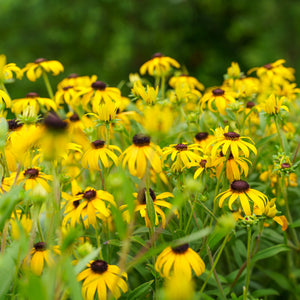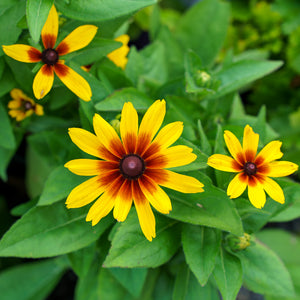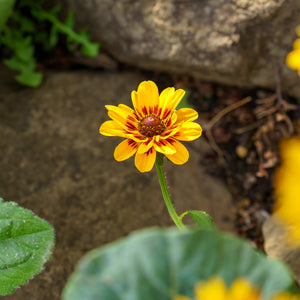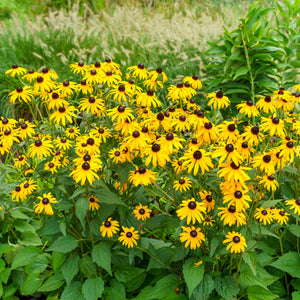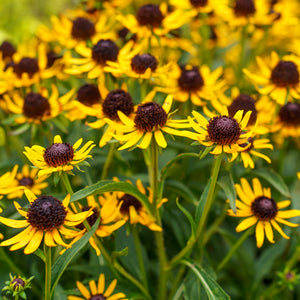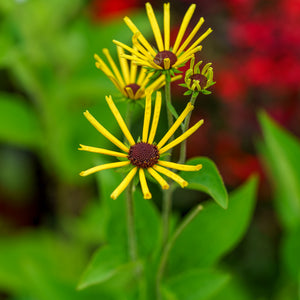The Rudbeckia Guide
Rudbeckia, often known as black-eyed Susan, is a resilient, sun-loving plant that adds bold, golden-yellow blooms to gardens from midsummer into fall. With daisy-like flowers and dark cone centers, rudbeckia varieties range from compact annuals to towering perennials, offering extended seasonal interest and strong wildlife value. Their rugged constitution, long bloom time, and ability to thrive in difficult conditions make them indispensable in native gardens, meadow plantings, and mixed borders.
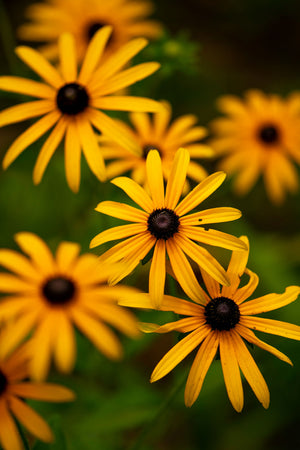
About
Rudbeckia is a genus in the Asteraceae family, native to North America. While many gardeners are familiar with Rudbeckia hirta, the genus includes numerous species and cultivars with varying habits, heights, and flower forms.
- Rudbeckia hirta varieties such as 'Denver Daisy' and 'Toto' are typically treated as annuals or short-lived perennials with large, bright flowers.
- Rudbeckia fulgida, including the classic 'Goldsturm' and 'Viette’s Little Suzy', are hardy perennials known for their reliable blooming and easy care.
- Rudbeckia subtomentosa 'Henry Eilers' and 'Little Henry' have uniquely rolled petals and tall, airy growth perfect for back-of-border plantings.
- Rudbeckia maxima, or giant coneflower, stands out with blue-green foliage and towering stems that add vertical drama.
- Compact cultivars like 'Little Goldstar' and 'American Gold Rush' provide mildew resistance and tidy mounds of continuous blooms.
- For wild, naturalistic charm, Rudbeckia triloba 'Prairie Glow' and Rudbeckia laciniata bring a layered, native look to cottage gardens and pollinator habitats.
Rudbeckia is a key component of prairie ecosystems and plays a central role in pollinator-friendly garden designs.
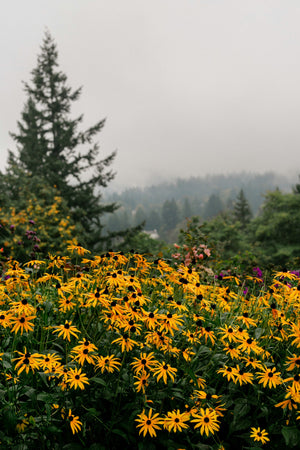
PLANTING
Rudbeckia is easy to grow and thrives in a wide range of garden conditions:
- USDA Hardiness Zones: Zones 3–9, depending on species.
- Soil: Tolerates most soil types but prefers moderately fertile, well-drained soil. Avoid soggy sites.
- Sunlight: Full sun is best for maximum bloom and sturdy stems.
- Spacing: Space plants 12–24 inches apart based on variety size.
- Planting Time: Plant in spring after frost, or in early fall in mild climates.
Rudbeckia can be started from seed, plugs, or transplants. When planting, position the crown at soil level, water well, and mulch lightly to retain moisture.
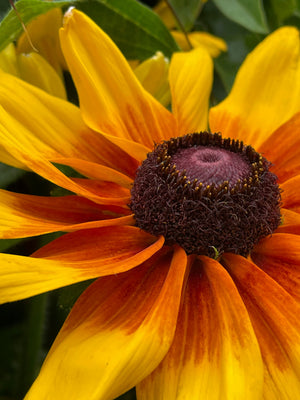
CARE
Low-maintenance and vigorous, rudbeckia requires only occasional care once established:
- Watering: Water regularly during establishment. Once mature, most varieties are drought-tolerant.
- Fertilizing: Not usually needed in rich soils. In poor soil, apply compost or a light dose of balanced fertilizer in spring.
- Deadheading: Remove spent blooms to encourage prolonged flowering and prevent unwanted self-seeding.
- Pruning: Cut stems to the ground in late fall or early spring. Taller varieties may benefit from staking.
- Dividing: Divide perennial types every 3–4 years to rejuvenate growth and control spread.
- Pests & Diseases: Rudbeckia is relatively pest-free. Watch for powdery mildew on Rudbeckia fulgida—choose resistant cultivars like 'American Gold Rush' for better performance.
This tough plant rewards minimal care with weeks of vibrant blooms and robust pollinator activity.
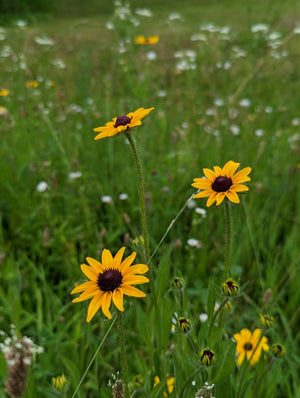
HOW TO USE
With its classic color and versatile growth habits, rudbeckia suits nearly any sunny garden:
- Pollinator Gardens: Rudbeckia is a magnet for bees, butterflies, and beneficial insects. 'Prairie Glow' and 'Henry Eilers' are particularly attractive to pollinators.
- Meadow & Prairie Plantings: Combine with echinacea, liatris, monarda, and grasses for a long-blooming native landscape.
- Borders & Mass Plantings: Use 'Goldsturm' or 'Little Goldstar' in large sweeps for golden, late-season color.
- Containers: Compact selections like 'Toto' or 'Giggling SmileyZ' bring bright cheer to pots and patio edges.
- Cut Flowers: Long stems and bold blooms make rudbeckia excellent for fresh bouquets and vase arrangements.
Pair rudbeckia with agastache, salvia, coreopsis, or ornamental grasses for eye-catching, drought-tolerant combinations.
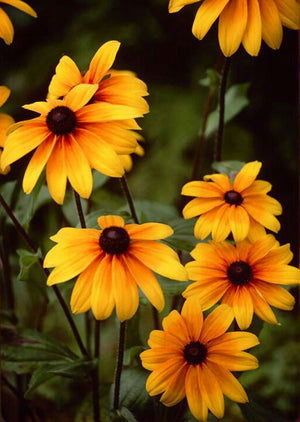
COMMON QUESTIONS
- Is rudbeckia a perennial? Many species are perennials, including Rudbeckia fulgida and Rudbeckia subtomentosa. Rudbeckia hirta is often grown as an annual or biennial.
- What is the largest rudbeckia? Rudbeckia maxima can reach 5–7 feet tall with large blue-gray leaves and bold yellow flowers.
- Do deer eat rudbeckia? Rudbeckia is generally deer-resistant due to its rough leaves and bitter taste, though feeding may occur in harsh conditions.
- Do rabbits eat rudbeckia? Rabbits occasionally nibble young shoots but tend to avoid mature plants.
- Is rudbeckia toxic to dogs? Rudbeckia is not considered toxic to dogs.
- Is rudbeckia toxic to cats? Rudbeckia is not known to be toxic to cats.
- Does rudbeckia spread? Some species spread by rhizomes or self-seeding. Divide or deadhead to control unwanted spread.
- How to grow rudbeckia? Plant in full sun, water to establish, and deadhead regularly. Minimal maintenance is needed once it’s established.
- When to plant rudbeckia? Spring and early fall are ideal for planting, giving roots time to develop before extreme weather.
- Does rudbeckia come back every year? Perennial varieties will return year after year. Annual types may self-seed and reappear under favorable conditions.
Conclusion
Rudbeckia is a dependable and brilliant performer in sunny landscapes, delivering bold color, pollinator support, and season-long interest. Whether you’re building a native prairie patch or filling out a summer border, rudbeckia provides cheerful blooms and easy care that even beginner gardeners can manage. With cultivars in every shape and size—from compact mounds to towering giants—this classic North American wildflower earns its place in gardens large and small.
The Rudbeckia Collection
Sold Out
Sold Out

